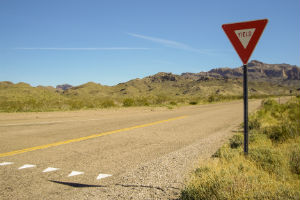 Arizona has several right-of-way laws in place to help prevent auto accidents caused by drivers who failed to yield.
Arizona has several right-of-way laws in place to help prevent auto accidents caused by drivers who failed to yield.
Arizona right-of-way laws help determine when a person can proceed into an intersection, enter certain roadways, or merge into traffic. They also establish motorists’ duty toward pedestrians and cyclists sharing the roadway.
If you or someone you love was injured in an accident caused by another driver’s negligence, contact Phillips Law Group. Our Phoenix auto accident attorneys can review the details of your claim during a free, confidential consultation. We can also discuss which options may be available for you to recover from the injuries you sustained in an accident.
Arizona has specific right-of-way rules that vary depending on the type of intersection they apply to. This includes:
A controlled intersection is one that has traffic lights, yield signs or stop signs to control traffic. Motorists must obey traffic lights and signals at controlled intersections. However, they should also look before entering an intersection and not assume that the roadway is clear.
When approaching a green light at an intersection, carefully drive through it at a steady speed. If the light has been green for a while, be prepared to stop when it turns yellow.
If you approach a controlled intersection with a yield sign, slow down or stop if necessary and wait until the way is clear before driving through the intersection. Likewise, if you approach a controlled intersection with a stop sign, come to a complete stop and drive through only when the path is clear.
An uncontrolled intersection is one that does not have a traffic signal or light. This includes intersections where the signal or light is inoperative.
Motorists must treat an uncontrolled intersection as if they were approaching a four-way stop. When two vehicles from two different streets or highways enter the intersection at the same time, the driver on the left must yield the right-of-way to the driver on the right.
A T-intersection is when two roads meet and form a “T” shape. The driver on the bottom road of the “T” must yield the right-of-way to drivers traveling on the road of the top of the “T.”
Likewise, if a driver traveling in the left lane is on a continuing street while the driver in the right lane is on a street that is ending, the driver on the right must yield to the vehicle on the continuing street.
A vehicle that is on an acceleration lane, ramp, or other approaching road must yield the right-of-way to existing traffic when merging onto a freeway.
Motorists must yield the right-of-way to pedestrians who are crossing the street. This applies to pedestrians who are in marked and unmarked crosswalks.
Additionally, motorists must yield to pedestrians walking through intersections when the light turns green.
Furthermore, a motorist must come to a complete stop at any school crossing when anyone is in the crosswalk. A motorist cannot pass another vehicle that is allowing pedestrians to cross.
If a motorist is emerging from an alley or driveway, he or she must stop before reaching the sidewalk. Then, the motorist must yield the right-of-way to any pedestrians or approaching vehicles.
Motorists making a left run must always yield the right-of-way to oncoming traffic. Additionally, the driver reaching the intersection first has the right-of-way unless he or she is turning left.
Furthermore, when two vehicles reach the intersection simultaneously, the one on the left must yield to the vehicle on the right-hand side.
Motorists in Arizona are usually permitted to make a U-turn if they can do so safely, do not interfere with traffic, or violate any signs to the contrary. However, they must yield to approaching traffic when making this maneuver.
Emergency vehicles must be given the right-of-way when they activate their sirens and begin flashing emergency lights. This applies to the following types of emergency vehicles:
There are several right-of-way rules that must be followed when traveling through or entering a roundabout:
Arizona right-of-way laws were designed to improve safety while traveling through intersections. Failing to abide by these laws can have serious consequences, including fatal auto accidents.
If you or a loved one suffered an injury in a right-of-way accident, do not hesitate to contact the skilled Phoenix personal injury attorneys at Phillips Law Group for a free, no-obligation consultation. We can discuss your claim and the accident that caused your injury to determine if you may be entitled to pursue compensation for your pain and suffering.
We provide all our services on a contingency fee basis, so you only have to pay us if we recover compensation for your claim.
Call 602-222-222 to schedule a free consultation today.